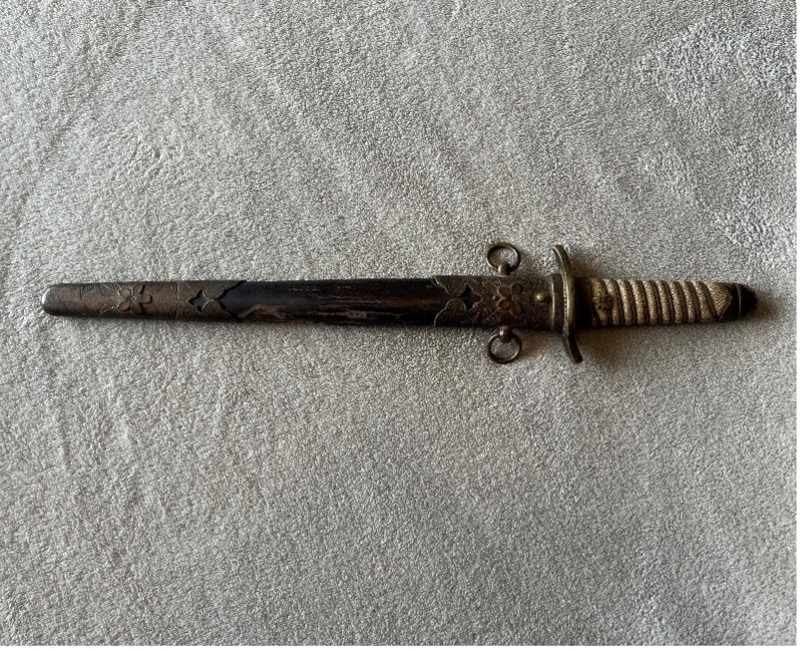
Reflection by Ethan Clinchard, UCARE Student and Intern
Like many others, some of my earliest memories involve going to my grandmother’s house. My nana, Jean Eileen Durgin-Clinchard, owned a house with a cozy finished attic, which was home to old letters, souvenirs from international travel, and—my favorite—her father’s dagger from his service in World War II.
Although my grandmother is no longer with us, I will always remember the stories she told me about growing up during the Second World War. Regarding my great-grandfather’s dagger, she recalled that, at the end of WWII, American and Japanese naval officers exchanged knives, daggers, and swords in a ceremony symbolizing the end of brutal conflict and the beginning of a new, more peaceful chapter between the nations. Her father, Calvin Thornton Durgin, was promoted to Vice Admiral at the end of the war, and he exchanged daggers with a Japanese Vice Admiral.

I grew up hearing many stories about his experience as a fleet commander in the Pacific Theater of Operations. One story, in particular, always stood out to me. The family lore goes like this: Durgin, as a naval pilot in World War I, was solo flying over the ocean. While approaching his fleet’s aircraft carrier, he noticed that the landing gear was stuck inside the plane. Fearing the worst, he crawled out of the cockpit and partially onto the wing to kick the landing gear down, successfully landing the plane on the carrier.
I recounted this story numerous times to family, friends, and colleagues. Once I joined the Nebraska Stories of Humanity project, I repeated this story to Dr. Beth Dotan. Since starting the project, I have encountered numerous family legends. For instance, Roy Long, who set a national record as a halfback for the Nebraska Cornhuskers, nudged the wire of a “bouncing betty” explosive mine with his foot, just barely avoiding disaster. When the flap was lowered on his landing craft, Melvin Thielbar stepped too far to the right, falling into the water. The serviceman standing next to Melvin was shot and instantly killed; Melvin had a crease in his helmet. Norman Smith helped capture the “Eagle’s Nest” in Berchtesgaden, Germany—Hitler’s private residence. He and his fellow comrades looted the residence while they were stationed there, and Norm even shipped home one of 12 silver-framed photos of Adolf Hitler, originally intended as an award for top S.S. officers. All of these stories have been captured and preserved through the digitization efforts of the Nebraska Stories of Humanity project.
Since my grandmother passed away, my family has gone through her belongings, which include some of her father’s possessions. Among the piles of documents, my father stumbled upon an original letter from his grandfather—the Vice Admiral. This letter detailed the unembellished story of his flight: During WWI, as a naval officer, he was flying with his comrade over the ocean. Shortly after taking off, they realized that the landing gear wasn’t retracting. Calvin really did climb out of the cockpit and onto the wing while the plane was flying to kick the landing gear, but he was unsuccessful. They were forced to bail into the water, where they waited for a nearby American boat to rescue them. Fortunately, both emerged relatively unscathed.
To me, this story demonstrates one of the key lessons I’ve learned during my time on the Nebraska Stories of Humanity project: original documents—primary sources—bring those who are no longer with us back to life. Individuals with incredible stories who are no longer able to share their narratives are personified through their writings, awards, artifacts, and the stories that are shared about them.
Through my work on this project—transcribing books, recording and captioning testimonies, evaluating and scanning artifacts, and much more—I have been fortunate enough to experience a bit of the same feeling my father and I felt when reading the Vice Admiral’s letter for the first time. It’s a feeling I can only imagine the families of the survivors and liberators highlighted in this project experience when they connect with their own history through these materials.
The Nebraska Stories of Humanity project has allowed me to enrich the community by embracing a pedagogy that emphasizes primary sources and learning history through the stories of individuals who have lived it. I have the unique opportunity to serve this important mission while encountering inspiring family legends that remind me of my own family history.







